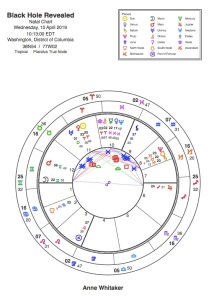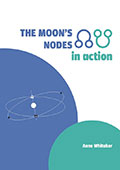‘…the combination of Nodal activity with the foreground presence of outer planets, especially Pluto, points out that something really special is going on…’ (i)
Today, the 10th of April, 2019, that something really special was a giant leap forward in our understanding of our magnificent cosmos: the first ever image of a black hole, from the galaxy Messier 87.
From the New York Times today:
‘…At the center of our galaxy lies Sagittarius A*, a black hole as massive as four million suns: The black hole is obscured by thick dust and a bright haze of superheated gases. A network of eight telescopes called the Event Horizon Telescope tried to use radio waves to peer through the dust cloud and glimpse the edge of the black hole. After years of analyzing data, the team did not release an image of Sagittarius A* on Wednesday. But it did catch a glimpse of something else: An even larger black hole, nearly 7 billion times the mass of the sun, sits at the heart of the nearby galaxy Messier 87…’
From an astrologer’s perspective:
The astrology of this event is stunning, as you see from the horoscope here, set for the time the updated image was released to the public from Washington DC this morning.
There is much to be commented on in this remarkable chart, but I will confine myself for now to the major factors which leapt out on first sight.
First off, we see the Moon’s South Node straddled by Pluto on one side, Saturn on the other in the eighth house of life’s deepest and darkest mysteries. The Nodal axis forms a dynamic T-Square from the eleventh house of the human collective, with the pioneering Aries Sun conjunct Eris, the battle goddess, and widely conjunct Uranus. To me this speaks of the vast destructive power of the energies involved, expressed vividly thus:
“…The images released today bolster the notion of violence perpetrated over cosmic scales,” said Sera Markoff, an astrophysicist at the University of Amsterdam, and a member of the Event Horizon team. “Black holes must be the most exotic major disrupters of cosmic order,” she said.(ii)
Next up, just look at that Moon rising in the twelfth house at 22.5 degrees of Gemini, opposite Jupiter in Sagittarius, straddling the Ascendant/Descendant axis at 25.5 degrees Gemini/Sagittarius. Not only does this pattern lie in the pair of signs connected to our endless quest for knowledge, but is closely plugged in to the planet Uranus’ discovery degree, ie 24 degrees 27 minutes Gemini, (which I wrote about in a recent post)
Furthermore, the chart’s ruling planet Mercury in the tenth house conjoins today’s beautiful, ethereal Venus /Neptune conjunction – with Neptune ruling the horoscope’s Pisces Midheaven, this line-up forming another T-Square with the Moon/Asc/Jupiter/Desc pattern.
I associate Pisces here on the MC, and its co-rulers Jupiter and Neptune, with our ancient human yearning to connect with those only dimly understood great forces of the universe which have held us in awe and stimulated our need to explore the farthest regions of both inner and outer space since the very beginning of human culture all those millennia ago.
Through the best efforts of human co-operation and pooling of knowledge shown by the tenth house placement of the Mercury/Venus/Neptune line-up, and the eleventh house placement of the Sun, we have arrived at – so far – the deepest place of understanding of the immensity of forces at work in our cosmos. This arrival is summed up in today’s vivid visual image, a picture worth more than a thousand words:
our first ever actual picture of one of the cosmos’ most powerful, destructive and mysterious objects: a Black Hole.
Endnotes:
(i)...from The Moon’s Nodes in Action by Anne Whitaker, p157
(ii)…from The New York Times 10.4.19
650 words copyright Anne Whitaker 2019
Licensed under Creative Commons – for conditions see Home Page of Writing from the Twelfth House






















































It’s amazing to think Einstein wrote about black holes, what a visionary mind. What next I wonder. The images were amazing!!! Wonderful post Anne 🙏🏻
LikeLiked by 1 person
Thanks, Carole, glad you like the post. It almost beggars belief that Einstein could have come up with this level of theoretical complexity – and be proved correct in practice so much later as a result of this amazing achievement.
LikeLike
it really is beyond words…also, the person that developed the algorithm that allowed to eventually produce the image is a young researcher, Katie Bouman, that was part of the 200 people team. I couldn’t find her DOB, but apparently she is 29…her first Saturn return, and part of the generation with THAT Capricorn stellium 🙂
LikeLike
That’s great information, Severne – it means her Saturn Return is plugged into that Saturn/S Node/Pluto line-up…how very appropriate. And yes, that Capricorn stellium generation is already proving to be extraordinary…
LikeLike
It really is beyond words…also, the person that developed the algorithm that allowed to eventually produce the image is a young researcher, Katie Bouman, that was part of the 200 people team. I couldn’t find her DOB, but apparently she is 29…her first Saturn return, and part of the generation with THAT Capricorn stellium
LikeLike
Hi sabrinarcos
thanks for the comment – don’t quite understand why it’s a repeat of Severne’s….
LikeLike
I knew that you’d comment on yesterday’s events. At first, I couldn’t understand how they could achieve a photo of a black hole, since photos depend on light, no light can escape from a black hole, etc. etc. Then, I at least figured out that it’s not an image of the black hole itself, but of the “event horizon” surrounding it. Obviously, more research is necessary on my part!
It’s just so phenomenal, in so many ways — and it certainly points out how far the younger generations have come in using new technologies that people my age find as mysterious as black holes!
LikeLiked by 1 person
Yes, well, I have two reactions when reading about those great leaps forward. One is amazement and pride at the sheer scale and range of our scientific and technical brilliance. The other is profound sadness that we are still unable to work out how to stop slaughtering one another…
LikeLike